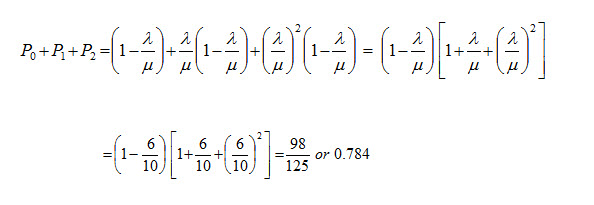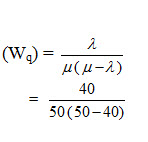Site pages
Current course
Participants
General
MODULE 1. Systems concept
MODULE 2. Requirements for linear programming prob...
MODULE 3. Mathematical formulation of Linear progr...
MODULE 5. Simplex method, degeneracy and duality i...
MODULE 6. Artificial Variable techniques- Big M Me...
MODULE 7.
MODULE 8.
MODULE 9. Cost analysis
MODULE 10. Transporatation problems
MODULE 11. Assignment problems
MODULE 12. waiting line problems
MODULE 13. Network Scheduling by PERT / CPM
MODULE 14. Resource Analysis in Network Scheduling
Lesson 4 Solved Examples
Example1 A television repairman finds that the time spent on his jobs has an exponential distribution with mean of 30 minutes. If he repairs sets in the order in which they came in, and if the arrival of sets follows a Poisson distribution approximately with an average rate of 10 per 8-hour day, what is the repairman’s expected idle time each day? How many jobs are ahead of the average set just brought in?
Solution
From the data of the problem, we have
λ = 10/8 = 5/4 sets per hour; and μ = (1/30) 60 = 2 sets per hour
(a) Expected idle time of repairman each day = Number of hours for which the repairman remains busy in an 8-hour day (traffic intensity) is given by
(8) (λ/μ) = (8) (5/8) = 5 hours
Hence, the idle time for a repairman in an 8-hour day will be: (8 – 5) = 3 hours.
(b) Expected (or average) number of TV sets in the system

Example2 On an average 96 patients per 24-hour day require the service of an emergency clinic. Also on an average, a patient requires 10 minutes of active attention. Assume that the facility can handle only one emergency at a time. Suppose that it costs the clinic Rs 100 per patient treated to obtain an average servicing time of 10 minutes, and that each minutes of decrease in this average time would cost Rs. 10 per patient treated. How much would have to be budgeted by the clinic to decrease the average size of the queue from one and one-third patients to half patient.
Solution From the data of the problem, we have

and ![]() patients per minute;
patients per minute; 
(i)Average number of patients in the queue

(ii)Fraction of the time for which there no patients,

(iii)When the average queue size is decreased from 4/3 patient, the new service rate μ is determined as:
 patients per minute.
patients per minute.
Average rate of treatment required is:  minutes, i.e. a decrease in the average rate of treatment is 2.5(= 10 – 7.5) minutes.
minutes, i.e. a decrease in the average rate of treatment is 2.5(= 10 – 7.5) minutes.
Budget per patient = Rs (100 + 2.5 x 10) = Rs 125 per patient.
Example 3 Customers arrive at a one-window drive according to a Poisson distribution with mean of 10 minutes and service time per customer is exponential with mean of 6 minutes. The space in front of the window can accommodate only three vehicles including the serviced one. Other vehicles have to wait outside this space. Calculate:
(a) Probability that an arriving customer can drive directly to the space in front of the window.
(b) Probability that an arriving customer will have to wait outside the directed space.
(c) How long an arriving customer is expected to wait before getting the service?
Solution From the data of the Problem, we have =6 customers per hour; = 10 customers per hour
(a) Probability that an arriving customer can drive directly to the space in front of the window:

(b) Probability that an arriving customer will have to wait outside the directed space:

(c) Expected waiting time of a customer before getting the service is:

Example 4: Students arrive at the head office according to a Poisson input process with a mean rate of 40 per hour. The time required to serve a student has an exponential distribution with a mean of 50 per hour. Assume that the students are served by a single individual, find the average waiting time of a student.
Solution.
Given, λ = 40/hour, μ = 50/hour
Average waiting time of a student before receiving service

= 4.8 minutes
Example 5: New Delhi Railway Station has a single ticket counter. During the rush hours, customers arrive at the rate of 10 per hour. The average number of customers that can be served is 12 per hour. Find out the following:
- Probability that the ticket counter is free.
- Average number of customers in the queue.
Solution.
Given
λ = 10/hour, μ= 12/hour
|
Probability that the counter is free = |
1 - |
10 |
= |
1/6 |
|
Average number of customers in the queue (Lq ) = |
(10)2 |
= |
25/6 |
|
Example 6: Universal Bank is considering opening a drive in window for customer service. Management estimates that customers will arrive at the rate of 15 per hour. The teller whom it is considering to staff the window can service customers at the rate of one every three minutes.
Assuming Poisson arrivals and exponential service find
- Average number in the waiting line.
- Average number in the system.
- Average waiting time in line.
- Average waiting time in the system.
Solution.
Given, λ = 15/hour, μ= 3/60 hour or 20/hour
|
Average number in the waiting line = |
(15)2 |
= |
2.25 customers |
|
|
|
||
|
Average number in the system = |
15 |
= |
3 customers |
|
|
|
||
|
Average waiting time in line = |
15 |
= |
0.15 hours |
|
|
|
||
|
Average waiting time in the system = |
1 |
= |
0.20 hours |